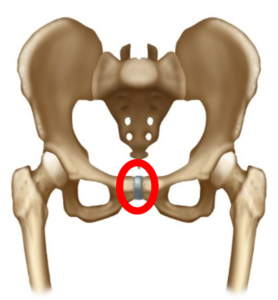Unfortunately, the physical and physiological changes during pregnancy can lead to various aches and pains in your pelvic area. If you’ve ever felt severe pain in your pubic area (front of your pelvis), this could be indicative of a common pregnancy pain called Symphysis Pubis Dysfunction (SPD).
In this post, we’ll help you understand the symptoms of SPD and common causes. Then, we’ll share some beneficial exercises to mitigate pain (or prevent it in the first place), and what to avoid to prevent it from getting worse.
SPD Symptoms
The most common symptom of SPD is severe pain in the pubic area (front of the pelvis). However, in some cases the pain radiates beyond this area down to the upper thighs and perineum (the area in between the anus and vagina). Similar to SI Joint Pain — another type of pelvic girdle pain felt in the posterior (or back) of the pelvis — SPD pain typically worsens with weight-bearing activity, especially single-leg activity (like walking, running, climbing stairs, or even getting in and out of a car). You might also feel pain when you widen your legs.
Common Causes of SPD
Pain is felt when there is increased stress on the pubic symphysis joint (circled in red below), which connects your left and right pelvic bones at the bottom of your pelvis.

During pregnancy, the following factors can create this increased stress:
- Pregnancy Alignment Shifts: Pregnancy tends to pull the body out of neutral alignment — often tipping the pelvis forward into an anterior pelvic tilt, as you can see in the image below. It also shifts the body’s center of gravity up and out. Together, the tipped pelvis plus shifted center of gravity places more weight on the pubic symphysis.

- Hormonal Changes: During pregnancy, hormonal changes — particularly the increase in a hormone called relaxin — relax the tension of the soft tissues in the body. This soft tissue laxity helps to increase mobility of the pelvis in preparation for birth. A consequence of this added pelvic motion is a decrease in stability of the bony structures, which can make the pubic symphysis joint hypermobile. This means that there is more movement than normal, which can lead to pain.
- Increased body weight: The increased weight as pregnancy progresses elevates the forces going through the pelvis, which accentuates the two issues above.
Note: Since some hormonal changes from pregnancy continue into the postpartum period, the increased mobility and decreased stability could still be present after giving birth (there is debate as to how long this period lasts), so that is why SPD can also occur in the postpartum period.
6 Exercises to Focus On
Now that you understand the contributing factors that can lead to SPD, it’s time to focus on the things you can do to help support your body to mitigate SPD symptoms, or avoid it altogether:
1. Find Neutral Alignment: OK, so this first one is not technically an “exercise,” but it is one of the most important tips to help mitigate SPD. It has to do with getting your body into neutral alignment to minimize pressure on pubic symphysis joint. Watch the video below to learn how to get your body into neutral alignment, and try to keep this in mind as you go about your day — especially during long periods of standing or walking.
2. 360° Breathing: Once you’re in neutral alignment, this is the first and most fundamental move to master. It activates your deep core muscles, which are critical for providing stability to the pubic symphysis joint. Watch this video to learn how to master the technique, then (importantly) incorporate it into your movements.
3. Pelvic Floor Activations (PFAs): One of the key responsibilities of the pelvic floor muscles is to assist in stabilizing the pelvis. The stronger these muscles are, the more they can support your pelvis, which minimizes stress on the pubic symphysis joint. Watch this video to learn a step-by-step process to first find your pelvic floor muscles (HINT: they’re not just your “pee-stopping” muscles), then learn how to work these muscles through a full range of motion coordinated with your 360° Breathing.
4. Bridges: Your glutes work with your core to stabilize your pelvis, so strengthening your glutes is important for mitigating SPD pain. Bridges are a great way to target your glutes because they keep your pelvis in a stable position. This is also a safe exercise to do throughout pregnancy because, even though you are on your back, you are moving the entire time. Of course, if you are uncomfortable being on your back, you can do this bridge with shoulders elevated variation.
5. Ground Pickup (or Deadlift): The Ground Pickup is essentially a Deadlift, but we refer to it this way because we want you to associate this action with how you pick things up off the ground in your daily life. Like bridges, this movement also targets the glutes while keeping the pelvis in a stable position.
6. Incline Plank: The plank is a great exercise that helps to stabilize the front of the pelvis and strengthen the glutes. Since full planks should be modified as pregnancy progresses, you can perform this simple regression on an incline to get the core strengthening benefit without excessively taxing the abdominal muscles.
3 Types of Exercises to Avoid
If you are experiencing SPD symptoms, then avoid the types of movements below. Note, it’s not necessary to avoid these movements if you are not experiencing SPD pain.
- Single-leg moves: During lunges, step-ups, or other single-leg pattern, the pelvis becomes loaded more on one side than the other, which can exacerbate pain. Therefore, stick to bilateral moves, such as squats and deadlifts, with even loads on both sides.
- Impact: Impact moves like running, jumping, or other ballistic moves will likely aggravate pain given the hypermobility in your pelvis. Your body will let you know if these moves are not appropriate.
- Spreading both legs at once: Doing any movement where both legs are spread (i.e. wide plies, straddle positions, or any stretches spreading legs apart) can put a lot of excess strain on the pubic symphysis joint, which is already under a lot of stress. If you want to stretch the inner thigh/groin area, do so gently on one side at a time.
Additional Support
- If you have painful symptoms, consider wearing a compression garment. We love the range from SRC Health, which offers high-quality garments to wear under and over your bump (use code PRONATAL10 for 10% off).
- For programs and services to help you exercise safely and effectively during pregnancy, check out our training programs & services.
- If you are a health & fitness pro interested in coaching pre & postnatal clients, explore our ProNatal Education & Certification.
Affiliate Notification: The post contains an affiliate link for SRC health. We may earn a commission from purchases made through this link. However, we only endorse companies that we have personally vetted and believe in.
